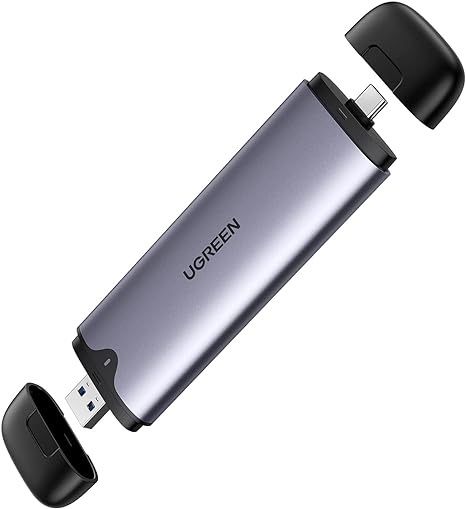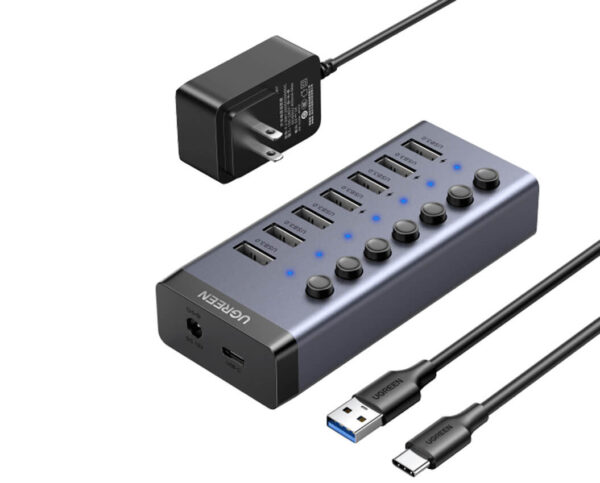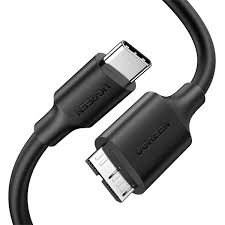UGREEN M.2 SATA SSD Enclosure, with 2 in 1 USB-C and USB-A Interface – CM353
Key Features
- The USB 3.2 interface incorporates UASP & TRIM that enabling it to perform a 70% faster read speed and 40% faster write speed than the conventional USB 3.1 interface
- This M.2 SSD enclosure features the latest USB 3.2 Gen 2 and PCIe 3.0, which support an amazing data transmission rate up to 10 Gbp. It is faster enough to transfer 1GB of files in 1 second
KSh4,899.00 KSh5,500.00 EX-VAT
UGREEN M.2 SATA SSD Enclosure with 2-in-1 USB-C and USB-A Interface – CM353
The UGREEN CM353 transforms M.2 SATA SSDs into portable external drives through a compact aluminum enclosure. This tool-free case converts laptop upgrade SSDs or spare M.2 drives into high-speed storage that connects to any device via included USB-C and USB-A cables. Students can repurpose drives from laptop upgrades for portable project storage, while business professionals gain a cost-effective solution for creating fast backup drives or securely transporting sensitive data.
Key Features & Benefits
- Tool-Free Installation: Slide your M.2 SATA drive into place without screwdrivers or technical expertise, getting your portable storage ready in under 30 seconds through a simple push-and-click mechanism.
- Dual Cable Interface: Includes both USB-C to USB-C and USB-C to USB-A cables in the package, ensuring compatibility with any computer, tablet, or phone without purchasing additional adapters.
- 6Gbps SATA III Speed: Delivers transfer rates up to 550 MB/s with compatible SSDs, moving a 10GB video file in approximately 20 seconds—significantly faster than traditional portable hard drives.
- Aluminum Heat Dissipation: All-metal construction efficiently disperses heat during sustained transfers, protecting your SSD and maintaining consistent performance even when moving hundreds of gigabytes.
- Universal M.2 SATA Compatibility: Supports M.2 SATA SSDs in 2242, 2260, and 2280 sizes from Samsung, Crucial, Western Digital, and all major manufacturers, giving new life to old upgrade drives.
Technical Specifications
Performance
- Interface: USB 3.1 Gen 2 (10 Gbps)
- Protocol: SATA III (6 Gbps)
- Maximum Transfer Speed: Up to 550 MB/s (dependent on SSD performance)
- UASP Support: Yes, for optimized transfer speeds
- TRIM Support: Yes, maintains SSD health and performance
Compatibility
- SSD Type: M.2 SATA SSDs only (B-Key and B+M Key)
- SSD Sizes: 2242, 2260, 2280 (42mm, 60mm, 80mm lengths)
- Maximum Capacity: Supports drives up to 2TB
- Important: NOT compatible with M.2 NVMe SSDs
Physical Design
- Dimensions: 108mm × 32mm × 10mm (4.3″ × 1.3″ × 0.4″)
- Weight: 32g (1.1 oz) without SSD
- Material: Aluminum alloy body with thermal pad
- Color: Space Gray
- Installation: Tool-free sliding mechanism
Included Cables
- USB-C to USB-C Cable: 30cm (11.8″) for laptops and modern devices
- USB-C to USB-A Cable: 30cm (11.8″) for traditional USB ports
- Both cables support USB 3.1 Gen 2 speeds
System Compatibility
- Windows 7 or later
- macOS 10.6 or later
- Linux
- Android with OTG support
- iPadOS 13 or later
- Chrome OS
- Xbox Series X/S, PS5 (for expanded storage)
Features
- Hot-Swappable: Connect/disconnect without restarting
- LED Indicator: Shows power and activity status
- Sleep Mode: Automatic power saving when idle
- Bus-Powered: No external power adapter needed
Use Cases & Applications
For Students
Repurpose the SSD from your laptop upgrade into portable storage. When you install a larger SSD in your laptop, don’t let the original 256GB or 512GB drive sit unused—the CM353 transforms it into valuable portable storage for projects, research materials, and media files.
Create fast backup storage for important assignments and research. External SSDs in this enclosure back up your entire semester’s work in minutes rather than hours, providing insurance against laptop failures before major deadlines.
Transport large video projects and design files between campus and home. The SSD’s speed handles 4K video footage and design software projects smoothly, while the compact size fits easily in backpacks alongside textbooks.
For Business Professionals
Build secure portable drives for sensitive client data. SSDs offer better shock resistance than traditional hard drives—important when carrying confidential information in briefcases or laptop bags through airports and client sites.
Create fast backup solutions for critical business documents. The high transfer speeds make daily backups practical rather than tedious, encouraging consistent backup habits that protect against data loss.
Transfer large presentation materials and design files quickly between office locations. Moving gigabytes of data between work computers becomes a minutes-long task rather than a workflow bottleneck.
For IT Professionals & System Builders
Test and diagnose M.2 SATA drives removed from systems. Quickly verify drive health and recover data from computers undergoing repair or replacement without installing drives into working systems.
Clone drives for system migrations and upgrades. Connect both source and destination M.2 drives (using two enclosures) to perform disk-to-disk copies during hardware upgrades.
Maintain portable toolkits with bootable operating systems. Create portable Windows or Linux installations on M.2 SSDs for system recovery, diagnostics, or demonstrations.
For Laptop Upgrade Projects
Don’t waste perfectly good SSDs after upgrading storage capacity. The original drive from your laptop upgrade gains new life as fast external storage, proving more cost-effective than buying new portable SSDs.
Create tiered storage solutions where frequently accessed files stay on internal drives while archives move to external SSDs. This approach maximizes expensive internal storage for active projects.
For Content Creators
Store video project files and raw footage on portable SSDs. The fast transfer speeds handle 4K and even 8K video editing workflows, with enough performance for direct timeline playback in many scenarios.
Maintain project archives organized by client or date. M.2 SSDs in these enclosures cost less than commercial portable SSDs while delivering equivalent performance for archival storage.
Transfer camera card dumps quickly in the field. The high speeds match or exceed many built-in card readers, making on-location backups faster and more reliable.
For Photography & Videography
Back up memory cards during shoots without slowing your workflow. The SSD speeds handle RAW photo batches and video files efficiently, providing redundant copies while you continue shooting.
Carry client delivery files on compact, professional-looking drives. The aluminum enclosure presents better than plastic cases during client handoffs of final projects.
For Gaming
Expand console storage with fast external SSDs. PS5 and Xbox Series X/S support external SSDs for storing backward-compatible games—M.2 SATA drives in this enclosure provide affordable expansion compared to internal NVMe upgrades.
Create portable game libraries that move between gaming PC and living room console. Load your favorite games onto the portable SSD and take your library wherever you play.
For Data Recovery & Salvage
Access data from laptops with damaged motherboards or broken screens. Remove the M.2 SATA drive, insert it into this enclosure, and recover files without expensive data recovery services.
Repurpose functional drives from obsolete or broken laptops. If the computer isn’t worth repairing but the SSD still works, the enclosure gives the drive continued usefulness.
Technical Considerations
This enclosure supports M.2 SATA SSDs only—it is NOT compatible with M.2 NVMe drives. The easiest way to identify your drive: M.2 SATA drives typically have two notches (B+M Key), while M.2 NVMe drives usually have one notch (M Key only). Check your drive specifications if unsure—using an NVMe drive in this SATA enclosure won’t work.
The maximum 550 MB/s transfer speed reflects SATA III’s bandwidth limitation. Even with USB 3.1 Gen 2’s 10 Gbps interface, SATA III’s 6 Gbps (approximately 550 MB/s after overhead) creates the bottleneck. This speed remains substantially faster than USB 2.0 or traditional hard drives.
UASP (USB Attached SCSI Protocol) support provides noticeable performance improvements compared to older mass storage protocols. Ensure your computer supports UASP (most Windows 8 and later, macOS 10.8 and later) to realize full performance potential.
The aluminum body serves dual purposes—structural protection and heat dissipation. SSDs generate heat during sustained operations, and the metal construction transfers heat away from the drive more effectively than plastic enclosures. The included thermal pad enhances heat transfer between SSD and case.
TRIM support helps maintain SSD performance and lifespan. TRIM commands tell the SSD which data blocks are no longer needed, enabling efficient background maintenance. Windows, macOS, and Linux generally enable TRIM automatically for USB-connected SSDs, though some older systems may require manual enabling.
Installation Process: Open the enclosure by sliding the aluminum shell off the plastic end cap. Insert your M.2 SATA drive into the slot at a 30-degree angle, then press down until it clicks into place. The spring-loaded mounting mechanism secures the drive without screws. Slide the aluminum shell back on, and your portable SSD is ready.
Drive Size Compatibility: The enclosure includes mounting points for 2242, 2260, and 2280 length M.2 drives (the numbers indicate length in millimeters). Most laptop M.2 drives are 2280 size, though some ultrabooks use 2242 or 2260. The enclosure accommodates all three through adjustable mounting.
Power Delivery: The enclosure draws power from the USB connection, eliminating external power adapters. M.2 SATA SSDs consume minimal power, well within USB bus power capabilities. However, some very old USB 2.0 ports or low-power devices may provide insufficient power—if the drive isn’t recognized, try different USB ports or USB 3.0 connections.
File System Considerations: Format the drive in the file system appropriate for your usage. Windows users typically use NTFS, macOS users prefer APFS or HFS+, and exFAT provides cross-platform compatibility between Windows and macOS at some performance cost. Format before first use or when repurposing drives from laptop installations.
Important Notes: Always safely eject the drive before disconnecting to prevent data corruption. The LED indicator lights during drive activity—wait for sustained inactivity before removal. The enclosure supports hot-swapping, but safe ejection remains best practice. When installing drives, ensure they’re fully seated before closing the enclosure—partially inserted drives can cause connection failures. The thermal pad that comes pre-installed should contact the SSD’s chips for optimal cooling—don’t remove it. For maximum performance, connect via USB 3.0 or higher ports (blue or teal colored USB ports typically indicate USB 3.0). If the drive isn’t recognized, verify it’s an M.2 SATA drive and not an M.2 NVMe drive, which requires different enclosures. Some M.2 drives have stickers or heat spreaders that increase thickness—if your drive doesn’t fit easily, don’t force it. Thin heat spreaders usually compress enough to fit, but very thick heat spreaders may need removal. Store the enclosure in a protective case when traveling to prevent damage to the USB-C port. The compact size makes the drive easy to misplace—consider attaching a keychain or bright cord for visibility. For professional data transport, encrypt the drive using BitLocker (Windows), FileVault (macOS), or VeraCrypt (cross-platform) to protect sensitive information if the drive is lost.







There are no reviews yet.